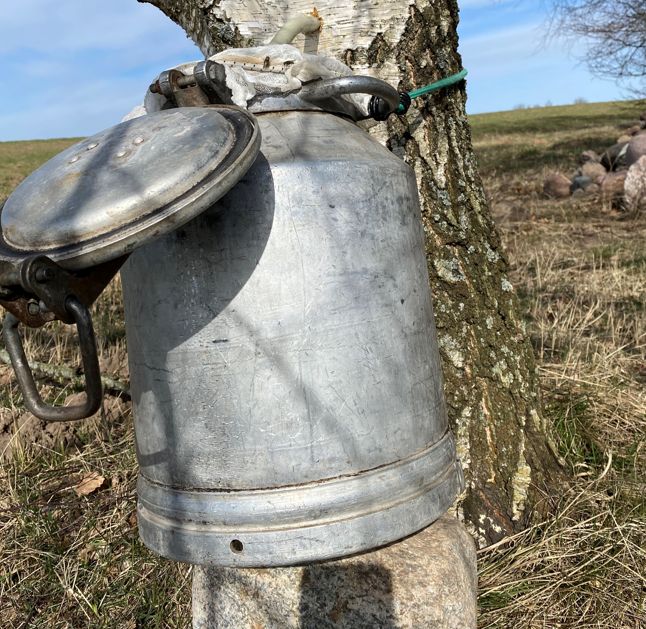Where and how to collect birch sap?

It's sap collecting time! Latvians have historically rooted traditions of extracting and drinking sap. You can buy birch and maple sap at the market and in many shops, but you can also do it yourself. The fact that it costs less to harvest your own sap, and that freshly harvested sap is healthier and more effective as a body cleanser, are all points in favor of harvesting your own. Sadly, commercially extracted sap will not be completely fresh and it is not known where and under what conditions the tree was grown.
Cheaper and healthier
As mentioned above, freshly collected sap is the healthiest, while those sold in shops or on the market will at best have been sitting around for 24 hours. The general price increase should also be taken into account. Assuming that a liter of juice costs around two euros, the three liters needed to cleanse the body per day will cost six euros. Assuming that we drink the sap for two weeks, this will be enough to start thinking about collecting our own birch sap. Those who have birch trees in the yard do not have to think long, but if there is no birch tree near the house, they can safely go to Latvia's State Forests' (LVM) areas, where each household is allowed to harvest sap for personal consumption. Under no circumstances should sap be extracted from trees in city parks, close to major roads and other places where environmental pollution is likely. Once the tree has been chosen, a drill, preferably one that is only 7 mm thick, should be taken, drilled to a depth of about 5 cm, a tube of the appropriate thickness inserted into the hole and a container left at the bottom. If a bucket or canister is used, it should be covered with cheesecloth to prevent debris and insects from getting into the sap. Sap harvesting kits are now available from Depo, Senukai and other stores, including easy-to-fit, sturdy bags for storing the juice.
What do you need to know about collecting sap in LVM areas?
Edmunds Linde, LVM Forestry Planning Manager: "As the air temperature rises, it's sap collecting time. Residents are allowed to collect sap for their own use free of charge on the territory of JSC Latvia's State Forests. Each resident is allowed to drill one borehole in Latvia's state forests to extract maple and birch sap. It is forbidden to extract sap from trees growing in nature parks and specially protected nature areas marked with the informative oak leaf sign. Protected areas are also visible in the mobile app LVM GEO.
If you wish to drill more than one borehole in trees growing in Latvia's state forests, this is a paid service in accordance with LVM's price list. A purchase agreement is signed with interested parties, and LVM forest district staff indicate the location where drilling can be carried out with the least damage to the forest. To obtain such a permit, contact the LVM representatives in the region where the sap is to be extracted. LVM monitors the locations where the sap harvesting permits have been issued and regularly inspects forests in the vicinity of settlements.
The State Forest Service can impose a fine for damaging trees with unauthorized sap extraction. According to Article 51 of the Law on Forests, a fine of up to €700 is imposed on natural persons and up to €1400 on legal persons for the unauthorized felling or damage of growing trees." State forest areas can be identified by yellow signs placed by JSC Latvia's State Forests at the edges of the property, and the boundary of the area is marked with yellow signs. The mobile app LVM GEO also allows you to easily and quickly find your location and see the boundaries of the state forests.
After drilling, you should also behave responsibly by regularly inspecting the drilled tree to avoid sap dripping over the edges of the container. In a living birch, a narrow and shallow borehole should not be sealed with a stopgap, as the stopgap is a foreign substance in the wood. The tree is quite good at filling its own wounds, and the stopgap is only needed in large holes to prevent fungal spores and infections from entering the tree. It is advisable to choose the same tree for drilling the following year.
It is recommended to use containers designed for storing foodstuffs and to pick sealed ones to prevent the sap from being exposed to atmospheric precipitation.
Important:
- The diameter of the tree at the drilling site must be greater than 40 cm (120 cm circumference). A small birch tree must not be drilled, as it needs all its strength to grow.
- Each borehole risks infecting the tree with rot. The drilling must be carried out with a drill no thicker than 6-8 mm.
- The borehole shall be drilled no higher than 50 cm from the ground and no deeper than 5 cm. The sap circulates close to the bark of the tree. If the borehole is drilled too deep - closer to the middle of the tree - there will be less and less sap, so there is no point in drilling deep. In addition, a deep borehole is also detrimental to the tree.
- It is forbidden to cut the bark down to the cambium.
- Sap flows better in trees that grow in full sun. It is better to drill on the sunny side, as the warm side of the tree wakes up more quickly and the circulation of sap is therefore stronger.
*****
Be the first to read interesting news from Latvia and the world by joining our Telegram and Signal channels.
